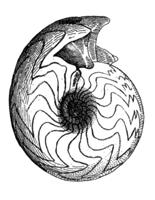- Goniatite
Taxobox
name = Goniatite
fossil_range = fossil range|400|251.4EarlyEarly Devonian -Late Permian

image_width = 155px
image_caption = Drawing of a goniatite fossil displaying
characteristic 'zigzag' sutures
regnum =Animal ia
phylum =Mollusca
classis =Cephalopod a
subclassis =Ammonoidea
ordo = Goniatitida
ordo_authority = Hyatt, 1884
| subdivision_ranks = Suborder
subdivision =
*Goniatitina
*Tornoceratina Goniatites are an extinct group of ammonoid, which are shelled
cephalopods related tosquid s,belemnite s,octopus es, andcuttlefish , and more distantly to thenautiloid s. Early in theDevonian period, some 400 million years ago, goniatites originated from within the more primitive anarcestine ammonoids. Surviving the Late Devonian biotic crises, goniatites flourished during theCarboniferous andPermian periods and finally became extinct in thePermian–Triassic extinction event at the close of thePaleozoic Era some 251.4 million years ago. They were survived by their cousins theceratite ammonoids, also descendants of the anarcestine ammonoids.Morphology
The goniatites all possessed an external shell, which is divided internally into chambers. The animal lived in the largest of the external chambers, and the internal chambers would have been filled with
gas , making the animal buoyant in the water. The general structure of the goniatites would have been similar to that of their relatives the ammonites, being a free swimming animal possessing a head with two well developed eyes and arms (ortentacle s).Goniatites are small to medium in size, almost always being less than 15 centimetres (6 inches) in diameter and often smaller than 5 centimetres (2 inches) in diameter. The shell is always planispirally coiled, unlike that of the later ammonites of the
Mesozoic era, some of which evolved into partially coiled or completely uncoiled forms (called heteromorphs). The shape of most goniatite shells suggests that they were poor swimmers.The thin walls between the internal chambers of the shell are called the "septa", and as the goniatite grew it would move its body forward in the shell secreting septa behind it, thereby adding new chambers to the shell. The "sutures" (or suture lines) are visible as a series of narrow, wavy lines on the surface of the shell. The sutures appear where each septa contacts the wall of the outer shell.
A distinctive feature of the goniatites is the "zigzag" pattern of their sutures. The sutures of nautiloids are by comparison somewhat simpler, being either straight or slightly curved, whereas later ammonoids showed suture patterns of increasing complexity. One explanation for this increasing extravagancy in suture pattern is that it leads to a higher strength of the shell.
Ecology
Ecologically, goniatites were limited to environments of normal-marine salinity -- as appears to be the case for all cephalopods throughout their history. Goniatites are much more abundant and speciose in rocks understood to represent cratonic (also called epicontinental or inland) sea sediments than they are in rocks understood to represent open ocean sediments. Within these inland seas, goniatites' greatest abundance and diversity appears to have been achieved in offshore
deep ramp andbasin al environments rather than in nearshore environments. Known nearshore (e.g.,lagoon al) occurrences have generally been ascribed to wash-in of shells from offshore waters.Due to lack of strong evidence for any particular life mode (e.g.,
nekton ic,plankton ic,demersal , planktivorous, piscivorous), it remains unclear what resources goniatites were capitalizing on in these offshore environments. Only a few goniatites' fulltrophic apparatuses have ever been described, and reports of stomach contents in these creatures' fossils remain questionable at best. However, goniatites clearly lacked the calcified jaw apparatuses developed later inammonoid history by theammonites ; this has been cited as evidence against a durophagous (shell-crushing) diet for goniatites.Distribution
Goniatites are found in
North America ,Europe ,North Africa andAustralasia . However, they seem to occur mostly in areas which at the time would have been tropical to subtropical. Most any fossil-bearing limestone or shale from inland seas of the late Paleozoic tropics or subtropics is likely to yield some goniatites. In the USA, such rocks are found fromMaine ,New York , andVirginia and in every state west toNebraska and south toTexas andAlabama ; as well as in parts of almost every western state (withNorth Dakota ,Oregon ,Washington , andHawai'i as the exceptions).Notable goniatite occurrences include the following: Certain
limestone s in western part of theRepublic of Ireland are packed with beautifully preserved goniatitefossil s. They are also found in marine bands of theCarboniferous coal measures inEurope , and in marine rocks of thePennsylvanian period inArkansas . Large numbers of goniatites occur in rocks from the Devonian period ofMorocco , and they are important zone, orindex fossil s used in dating the rocks of that period.ee also
*
Baculite
*Orthoceras
* "Lituites "
Wikimedia Foundation. 2010.
